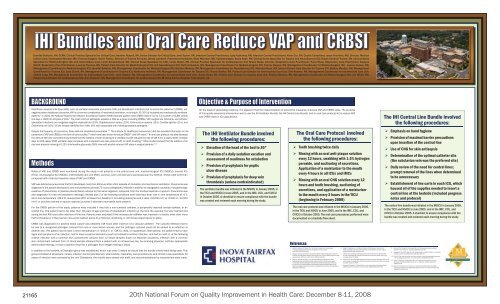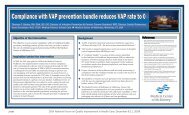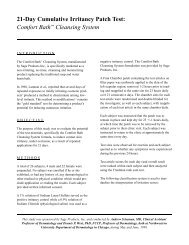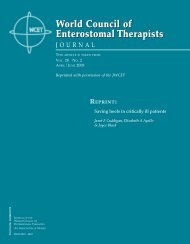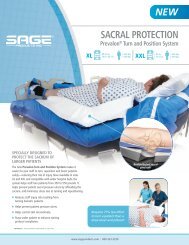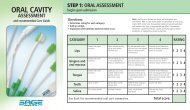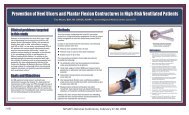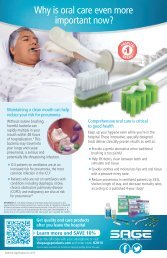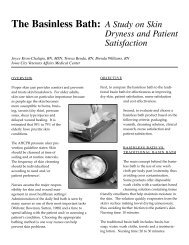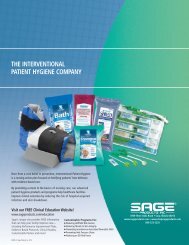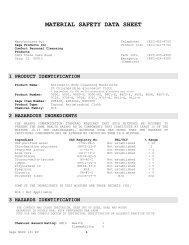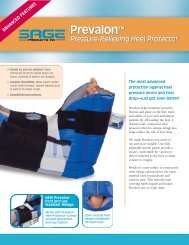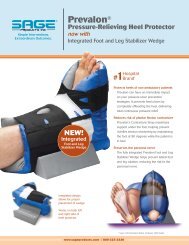IHI Bundles and Oral Care Reduces VAP and CRBSI_PV
IHI Bundles and Oral Care Reduces VAP and CRBSI_PV
IHI Bundles and Oral Care Reduces VAP and CRBSI_PV
- No tags were found...
Create successful ePaper yourself
Turn your PDF publications into a flip-book with our unique Google optimized e-Paper software.
20th Naonal Forum on Quality Improvement in Health <strong>Care</strong>: December 8-11, 200820th Naonal Forum on Quality Improvement in Health <strong>Care</strong>: December 8-11, 200820th Naonal Forum on Quality Improvement in Health <strong>Care</strong>: December 8-11, 200820th Naonal Forum on Quality Improvement in Health <strong>Care</strong>: December 8-11, 2008Dorothy Belkoski, RN, CCRN, Clinical Practice Specialist for Critical <strong>Care</strong>; Heather Russell, RN, Senior Director for Critical <strong>Care</strong>; Jane Tucker, RN, Infection Control Practitioner; Judy Hathaway, RN, Infection Control Practitioner; Karin Cox, RN, Quality Consultant; Jason Vourlekis, MD, Director, MedicalCritical <strong>Care</strong>; Christopher Michetti, MD, Trauma Surgeon; Samir Fahkry, Director of Trauma Services; James Lamberti, Pulmonary Intensivist; Allan Morrison, MD, Epidemiologist; Sonia Astle, RN, Clinical Nurse Specialist for Trauma <strong>and</strong> NeuroScience ICU; Nicole Gendron-Trainer, RN, Clinical NurseSpecialist for Medical-Surgical ICU <strong>and</strong> Intermediate <strong>Care</strong>; Linda Schakenbach, RN, Clinical Nurse Specialist for CCU; Linda Halpin, RN, Clinical Practice Specialist for Cardiovascular ICU; Shane Blake, Director, Respiratory <strong>Care</strong> Practitioner; Parul Shaw, Respiratory <strong>Care</strong> Practitioner; DwayneSmith, Respiratory <strong>Care</strong> Practitioner; Lavonia Thomas, RN, Patient <strong>Care</strong> Director for Medical-Surgical ICU <strong>and</strong> NeuroScience ICU; Faith Vonkleeck, RN, Management Coordinator for Medical-Surgical ICU; Tammy Rogers, RN, Management Coordinator for Medical-Surgical ICU ; Lauren Hocker, RN,Management Coordinator for Medical-Surgical ICU; Jennifer Kelleher, RN, Management Coordinator for Medical-Surgical ICU; Barbara Mooney, RN, Management Coordinator for NeuroScience ICU; Melinda Myers, RN, Interim Patient <strong>Care</strong> Director for Trauma ICU; Bethan Mendez, RN, ManagementCoordinator for Trauma ICU; Sara Clarke, RN, Management Coordinator for Trauma ICU; Katherine Hoffman, RN, Management Coordinator for Trauma ICU; R<strong>and</strong>y Walker, RN, Patient <strong>Care</strong> Director for Intermediate <strong>Care</strong> Unit; Toni Kastner, RN, Management Coordinator for Intermediate <strong>Care</strong> Unit;Valerie Long, RN, Management Coordinator for Intermediate <strong>Care</strong> Unit ; Julie Hessler, RN, Management Coordinator for Intermediate <strong>Care</strong> Unit ; Karen Hicks, RN, Patient <strong>Care</strong> Director for Cardiac <strong>Care</strong> Unit; Patricia Bakovic, RN, Management Coordinator for Medical-Surgical ICU; Jan White, RN,Patient <strong>Care</strong> Director for Cardiovascular ICU; Ann Newman, RN, Management Coordinator for Cardiovascular ICU Inova Fairfax Hospital, Falls Church, VAHealthcare–acquired infections (HAIs), such as ventilator-associated pneumonia (<strong>VAP</strong>) <strong>and</strong> bloodstream infections due to central line placement (<strong>CRBSI</strong>), are On the basis of preexisting evidence, it is apparent that the implementation of preventive measures improves <strong>VAP</strong> <strong>and</strong> <strong>CRBSI</strong> rates. The purposenegative patient healthcare outcomes. <strong>VAP</strong> is a common complication of mechanical ventilation, occurring in 10–20% of intubated <strong>and</strong> mechanically ventilated of this quality-assurance intervention was to use the <strong>IHI</strong> Ventilator Bundle, the <strong>IHI</strong> Central Line Bundle, <strong>and</strong> an oral care protocol/kit to reduce <strong>VAP</strong>patients. 1 In 2004, the National Nosocomial Infection Surveillance System (NNIS) reported pooled mean <strong>CRBSI</strong> rates of 3.2 to 7.4 (number of CLBSI central <strong>and</strong> <strong>CRBSI</strong> rates in ICU populations.line days x 1000) for all types of ICUs. 2 The most common pathogens isolated in HAIs as a group (including <strong>CRBSI</strong>s, <strong>VAP</strong>, surgical site infections, <strong>and</strong> catheterassociatedinfections) are coagulase-negative staphylococci (15%), Staphylococcus aureus (15%), Enterococcus species (12%), C<strong>and</strong>ida species (11%), <strong>and</strong>Escherichia coli (10%). 3 Of the isolates identi ed from HAIs, 16% were associated with multidrug-resistant pathogens. 3Despite the frequency of occurrence, these HAIs are considered preventable. 4-6 The Institute for Healthcare Improvement (<strong>IHI</strong>) has provided information on theprevention of <strong>VAP</strong> <strong>and</strong> <strong>CRBSI</strong>s in the form of care bundles, 5,6 which have been shown to reduce <strong>CRBSI</strong> 4,7 <strong>and</strong> <strong>VAP</strong> rates. 8,9 An oral care protocol may also decrease The <strong>IHI</strong> Ventilator Bundle involvedThe <strong>Oral</strong> <strong>Care</strong> Protocol involvedthe rates of <strong>VAP</strong>. One controlled study showed that the addition of tooth brushing to a ventilator bundle reduced the rate of <strong>VAP</strong> (from 2 cases/1000 ventilatordays to 0.63 cases/1000 ventilator days) compared with a st<strong>and</strong>ard oral care protocol with no tooth brushing. 10 Other studies showed that the addition of anthe following procedures:the following procedures:oral care protocol involving a 0.12% chlorhexidine gluconate (CHG) rinse with alcohol reduced <strong>VAP</strong> rates in surgical patients. 11,12Rates of <strong>VAP</strong> <strong>and</strong> <strong>CRBSI</strong> were monitored during the study in all patients in the critical care unit, medical-surgical ICU (MSICU), trauma ICU(TICU), neurosurgical ICU (NSICU), intermediate care unit (IMC), coronary care unit (CCU),<strong>and</strong> cardiovascular ICU (CVICU). These rates were thencompared with historical baseline rates of <strong>VAP</strong> <strong>and</strong> <strong>CRBSI</strong>.<strong>VAP</strong> was de ned as pneumonia that rst developed more than 48 hours after a rst episode of intubation <strong>and</strong> mechanical ventilation. Pneumonia wasdiagnosed if the patient developed a new <strong>and</strong> persistent (at least 72 hours) radiographic inltrate in addition to radiographic cavitation, histopathologicevidence of pneumonia, or positive pleural/blood cultures for the same organism recovered from the tracheal aspirate or sputum. Pneumonia wasalso diagnosed if a new <strong>and</strong> persistent radiologic inltrate plus 2 of the following conditions were observed: fever (rise in core temperature of 1C<strong>and</strong> a core temperature >38.3C), leukocytosis (25% increase from baseline in circulating leukocytes <strong>and</strong> a value >10,000 mm 3 or 12,000mm 3 ), or purulent tracheal or sputum aspirate (purulent if abundant neutrophils were present).For the <strong>CRBSI</strong> portion of the study, patients were included if they had a non-tunneled catheter, a peripherally inserted central catheter, or anarterial line. The patient had to be older than 18 years of age <strong>and</strong> free of bloodstream infection at the time the vascular line was inserted <strong>and</strong>during the rst 48 hours after insertion of the line. Patients were excluded if the intravascular catheter was inserted in a facility other than InovaFairfax Hospital or if they had an intra-aortic balloon pump or a Hickman, Groshong, or ventricular assist device in place.<strong>CRBSI</strong> was diagnosed if a positive blood culture was obtained 48 hours after insertion of a vascular catheter. The cultured infection had tobe due to a recognized pathogen cultured from one or more blood cultures, <strong>and</strong> the pathogen cultured could not be related to an infection atanother site. The patient had to have a fever (temperature of >100.4F, or >38C), chills, or hypotension. Alternatively, the patient had to havesigns <strong>and</strong> symptoms of an infection, had to have a positive laboratory result not related to another infection, <strong>and</strong> had to meet 1 of the followingcriteria: infection with a common skin contaminant cultured from 2 blood samples drawn on separate occasions, infection with a commonskin contaminant cultured from 1 blood sample obtained from a patient with an intravenous line, be receiving physician institute–appropriateantimicrobial therapy, or have a positive result for a pathogen from antigen testing in blood.In addition to the bundles, a Champion group was established, which met every 2 weeks to ensure that the bundle criteria were being used. Thisgroup consisted of physicians, nurses, infection control practitioners, pharmacists, respiratory care practitioners, <strong>and</strong> clinical nurse specialists. Allcases of infection were reviewed by the unit Champions, the results were shared with staff, <strong>and</strong> recommendations for improvement were made.‣ Elevation of the head of the bed to 30°‣ Provision of a daily sedation vacation <strong>and</strong>assessment of readiness for extubation‣ Provision of prophylaxis for pepticulcer disease‣ Provision of prophylaxis for deep veinthrombosis (unless contraindicated)The ventilator bundle was initiated in the MSICU in January 2005, inthe TICU <strong>and</strong> NSICU in June 2005, <strong>and</strong> in the IMC, CCU, <strong>and</strong> CVICUin October 2005. A checklist to ensure compliance with the bundlewas created <strong>and</strong> reviewed each morning during the study.References:1.2.3.‣ Tooth brushing twice daily‣ Rinsing with an oral anti-plaque solutionevery 12 hours, swabbing with 1.5% hydrogenperoxide, <strong>and</strong> suctioning of secretions.Application of a moisturizer to the mouthevery 4 hours in all ICUs <strong>and</strong> IMCs‣ Rinsing with an oral CHG solution every 12hours <strong>and</strong> tooth brushing, suctioning ofsecretions, <strong>and</strong> application of a moisturizerto the mouth every 2 hours in the TICU(beginning in February 2008)The oral care protocol was initiated in the MSICU in January 2005,in the TICU <strong>and</strong> NSICU in June 2005, <strong>and</strong> in the IMC, CCU, <strong>and</strong>CVICU in October 2005. The oral care procedures performed weredocumented on a bedside ow sheet.Safdar N, Dezfulian C, Collard HR, et al. Clinical <strong>and</strong> economic consequencesof ventilator-associated pneumonia: a systematic review. Crit <strong>Care</strong>Med.2005;33(10):2184-2193.2National Nosocomial Infections Surveillance System. National Nosocomial InfectionsSurveillance (NNIS) System Report, data summary from January 1992 through June 224,issued October 2004. Am J Infect Control. 2004;32:470-485.Hidron AI, Edwards JR, Patel J, et al; National Healthcare Safety Network Team;Participating National Healthcare Safety Network Facilities. NHSN annual update:antimicrobial-resistant pathogens associated with healthcare-associated infections:annual summary of data reported to the National Healthcare Safety Network at theCenters for Disease Control <strong>and</strong> Prevention, 2006-2007. Infect Control Hosp Epidemiol.2008;29(11):996-1011.4.5.6.7.Galpern D, Guerrero A, Tu A, Fahoum B, Wise L. Effectiveness of a central linebundle campaign on line-associated infections in the intensive care unit. Surgery.2008;144(4):492-495; discussion 495.5 Million Lives Campaign. Getting Started Kit: Prevent Central Line Infections HowtoGuide. Cambridge, MA: Institute for Healthcare Improvement; 2008. www.ihi.org.Accessed October 28, 2008.5 Million Lives Campaign. Getting Started Kit: Prevent Ventilator-Associated PneumoniaHow-to Guide. Cambridge, MA: Institute for Healthcare Improvement; 2008. www.ihi.org.Accessed October 28, 2008.Pronovost P, Needham, D, Berenholtz S, et al. An intervention to decrease catheterrelatedbloodstream infections in the ICU. NEJM. 2006;355(26):2725-2732.The <strong>IHI</strong> Central Line Bundle involvedthe following procedures:‣ Emphasis on h<strong>and</strong> hygiene‣ Provision of maximal barrier precautionsupon insertion of the central line‣ Use of CHG for skin antisepsis‣ Determination of the optimal catheter site(the subclavian vein was the preferred site)‣ Daily review of the need for central lines;prompt removal of the lines when determinedto be unnecessary‣ Establishment of line carts in each ICU, whichhoused all of the supplies needed to insert acentral line at the bedside (included progressnotes <strong>and</strong> protocol)The central line bundle was initiated in the MSICU in January 2005,in the TICU <strong>and</strong> NSICU in June 2005, <strong>and</strong> in the IMC, CCU, <strong>and</strong>CVICU in October 2005. A checklist to ensure compliance with thebundle was created <strong>and</strong> reviewed each morning during the study.8. Cocanour CS, Peninger M, Domonoske BD, et al. Decreasing ventilator-associatedpneumonia in a trauma ICU. J Trauma. 2006;61(1):122-129.9. Youngquist P, Carroll M, Farber M, et al. Implementing a ventilator bundle in a communityhospital. Jt Comm J Qual Patient Saf. 2007;33(4):219-225.10. Fields LB. <strong>Oral</strong> care intervention to reduce incidence of ventilator-associated pneumoniain the neurologic intensive care unit. J Neurosci Nurs. 2008;40(5):291-298.11. Genuit T, Bochicchio G, Napolitano LM, et al. Prophylactic chlorhexidine oral rinsedecreases ventilator-associated pneumonia in surgical ICU patients. Surg Infect.2006;2(1):5-18.12. Koeman M, van der Ven AJ, Hak E, et al. <strong>Oral</strong> decontamination with chlorhexidinereduces the incidence of ventilator-associated pneumonia. Am J Respir Crit <strong>Care</strong> Med.2006;173(12):1348-1355.2116520th National Forum on Quality Improvement in Health <strong>Care</strong>: December 8-11, 2008
The interventions, which began in 2005 <strong>and</strong> continued through 2008, resulted in decreased rates of <strong>VAP</strong><strong>and</strong> <strong>CRBSI</strong>s in all critical care units (Figures 1 <strong>and</strong> 2). The most notable change occurred in the TICU, wherethe number of <strong>VAP</strong> cases decreased by 77%, from 10 cases (a rate of 31) in January 2008 to 2 cases (a rateof 7) in July 2008 (Figure 3). During this same time period, no <strong>CRBSI</strong>s were reported.Figure 2: <strong>VAP</strong> <strong>and</strong> <strong>CRBSI</strong> Rates in the TICU: 2005–2008Figure 3: <strong>VAP</strong> <strong>and</strong> <strong>CRBSI</strong> Rates in the TICU: 2008Figure 1: <strong>VAP</strong> <strong>and</strong> <strong>CRBSI</strong> Rates in Critical <strong>Care</strong> Units: 2005–2008Ventilator days: 5844 15,322 15,675 9,284Line days: 7,735 19,525 19,247 12,125n Quality Improvement in Health <strong>Care</strong>: December 8-11, 2008* <strong>VAP</strong> Rate = per 1000 ventilator days; <strong>CRBSI</strong> Rate = per 1000 patient daysSample size = 1,989 ventilator days; 1,897 line days* <strong>VAP</strong> Rate = per 1000 ventilator days; <strong>CRBSI</strong> Rate = per 1000 patient daysVentilator days: 5844 15,322 15,675 9,284Line days: 7,735 19,525 19,247 12,125Implementation of the <strong>IHI</strong> Ventilator Bundle contributed to a reduction in <strong>VAP</strong> ratesImplementation of the <strong>IHI</strong> Central Line Bundle contributed to a reduction in <strong>CRBSI</strong>s* <strong>VAP</strong> Rate = per 1000 ventilator days; <strong>CRBSI</strong> Rate = per 1000 patient days** Data for Jan. 2005 to May 2005 only re ects data for the MSICU; NSICU <strong>and</strong> TNICU were added June-Sept. 2005; CCU, CVICU <strong>and</strong>IMC were added in Oct. 2005; remainder is for all Critical <strong>Care</strong> units (CC)Provision of oral care every 2 hours <strong>and</strong> tooth brushing twice daily contributed to areduction in <strong>VAP</strong> ratesUse of a daily checklist <strong>and</strong> documentation of the oral care procedures followed on abedside chart helped to ensure staff compliance with the bundles <strong>and</strong> oral care protocolIntroduction of the <strong>IHI</strong> Ventilator Bundle, <strong>IHI</strong> Central Line Bundle, <strong>and</strong> an oral care protocol reduced rates of<strong>VAP</strong> <strong>and</strong> <strong>CRBSI</strong>s in the MSICU, NSICU, <strong>and</strong> TICU at Inova Fairfax Hospital (Falls Church, VA).Establishment of the multidisciplinary Champion group to track compliance <strong>and</strong> providevaluable feedback to the staff reinforced the benets of the prevention measures <strong>and</strong>encouraged staff compliance with the bundles <strong>and</strong> oral care protocol


